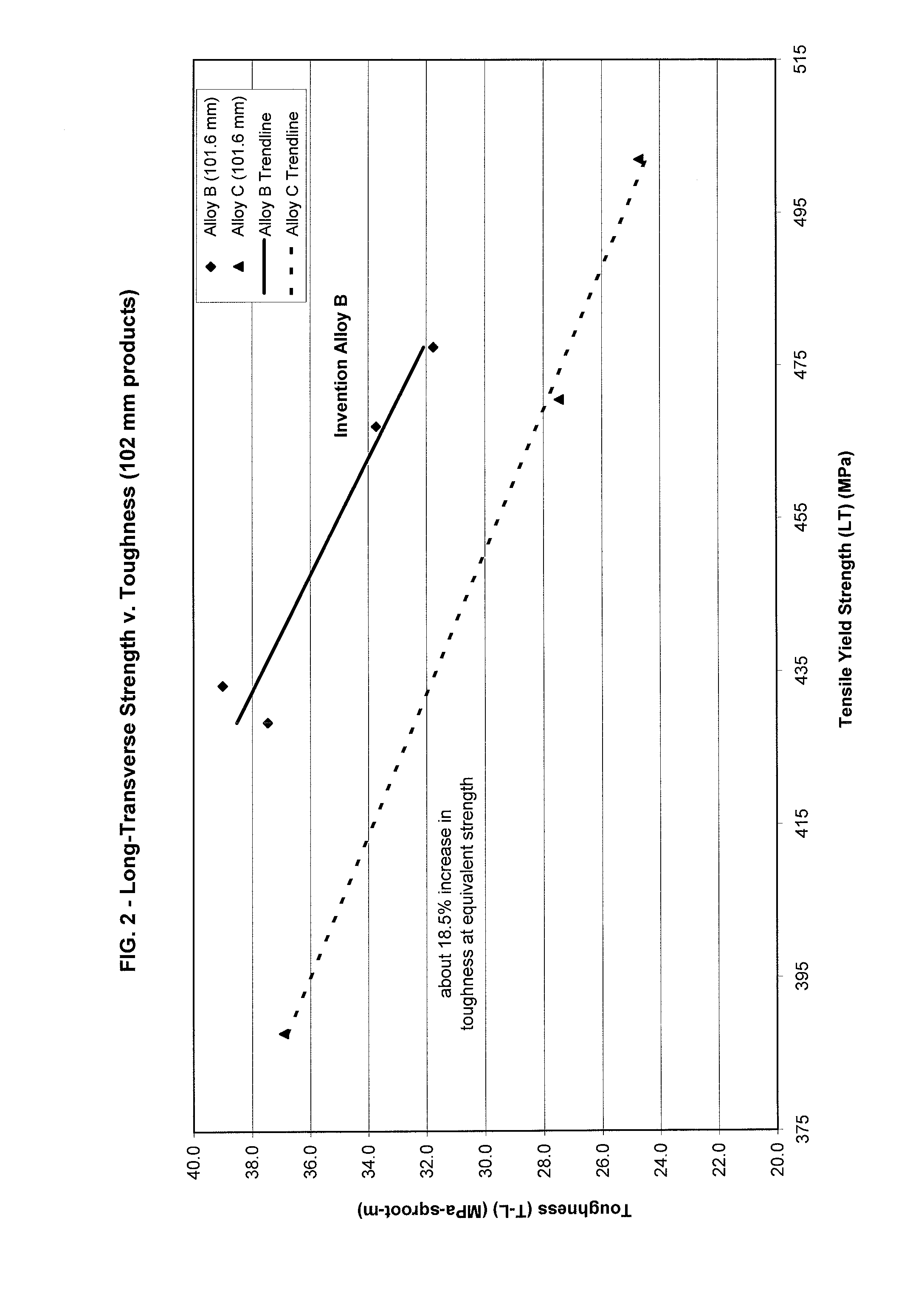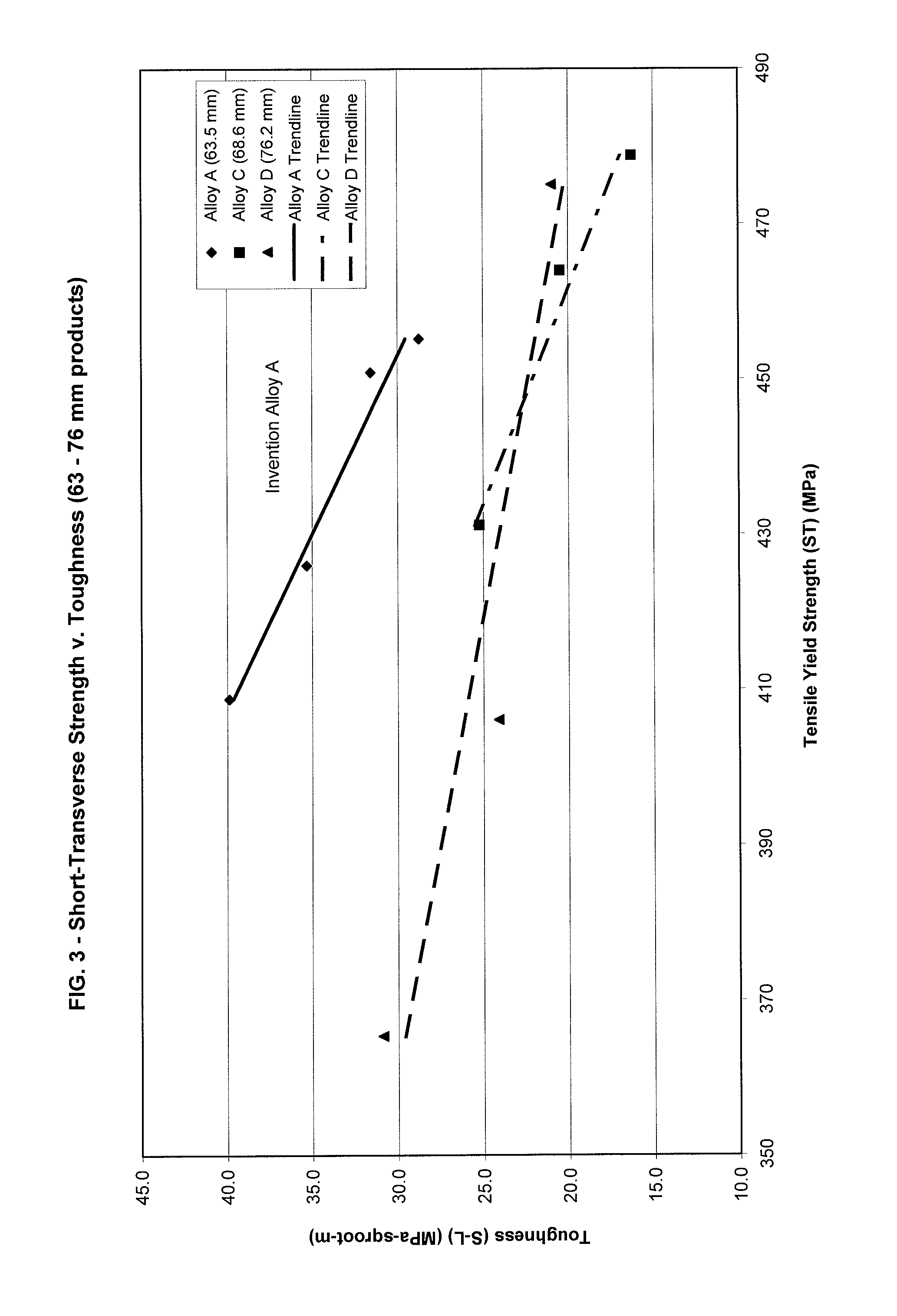2xxx series aluminum lithium alloys
a lithium alloy and aluminum alloy technology, applied in the direction of layered products, synthetic resin layered products, chemistry apparatus and processes, etc., can solve the problems of difficult to increase the strength of an alloy without decreasing the toughness of an alloy, and often elusive to achieve the effect of improving the combination of strength and toughness
- Summary
- Abstract
- Description
- Claims
- Application Information
AI Technical Summary
Benefits of technology
Problems solved by technology
Method used
Image
Examples
example 1
Plate Testing
[0035]Various Al—Li alloys are cast as rectangular ingot and homogenized. The scalped ingots had a thickness of 368.3 mm. The composition of each ingot is shown in Table 2a, below. Alloys A-B are invention alloys, while Alloys C-D are non-invention alloys.
TABLE 2aCOMPOSITION OF ALLOYSAlloySiFeCuMgMnZnTiZrLiA0.0180.0273.500.210.300.350.0190.1301.18B0.0150.0273.480.210.290.340.0170.1271.17C0.020.033.860.190.350.460.020.111.40D0.020.033.750.200.350.460.020.111.37
The balance of each alloy is aluminum and other elements, with no one other element exceeding 0.05 wt. %, and with the total of these other elements not exceeding 0.15 wt. %. The alloys are hot rolled, solution heat treated, quenched and stretched about 6%. Alloys C and D are rolled to two different gauges. The approximate final gauges are provided in Table 2b, below.
TABLE 2bALLOYS AND FINAL GAUGEFinal GaugeFinal GaugeAlloy(mm)(in.)A63.52.5B101.64.0C-168.62.7C-2101.64.0D-176.23.0D-2119.44.7
[0036]Various two-step ar...
example 2
Additional Plate Testing
[0040]Various Al—Li alloys are cast as rectangular ingots and homogenized with two ingots being produced per alloy. The scalped ingots had a thickness of 298 mm. The composition of each ingot is shown in Table 5, below. Alloys E-F are invention alloys. Alloy G is a non-invention alloy, and is similar to the alloy XXI disclosed in U.S. Pat. No. 5,259,897, which contained 3.5 wt. % Cu, 1.3 wt. % Li, 0.4 wt. % Mg, 0.14 wt. % Zr, 0.03 wt. % Ti, the balance being aluminum and impurities.
TABLE 5COMPOSITION OF ALLOYSAlloySiFeCuMgMnZnTiZrLiE0.030.043.270.250.240.380.020.111.21F0.030.043.270.260.240.310.020.111.19G0.020.033.480.390.010.020.020.111.29
[0041]The balance of each alloy is aluminum and other elements, with no one other element exceeding 0.05 wt. %, and with the total of these other elements not exceeding 0.15 wt. %. The alloys are hot rolled, solution heat treated, quenched and stretched about 6%. Alloys E and G are rolled to two different gauges. The appro...
example 3
Forged Products
[0047]An Al—Li alloy is cast as an rectangular ingot and homogenized, the composition of which is shown in Table 13, below. The scalped ingot had a thickness of 356 mm. Alloy H is an invention alloy.
TABLE 13COMPOSITION OF ALLOYAlloySiFeCuMgMnZnTiZrLiH0.020.033.500.210.300.350.020.131.18
The balance of the alloy is aluminum and other elements, with no one other element exceeding 0.03 wt. %, and with the total of these other elements not exceeding 0.12 wt. %. Several die forgings are produced from the ingot and in the T852 temper (i.e., hot forged to gauge, solution heat treated, quenched, cold worked about 6%, and then aged), after which the mechanical properties are measured. The results are provided in Table 14, below.
TABLE 14PROPERTIES OF DIE FORGED ALLOYGauge25.4 mm50.8 mm76.2 mm1st Step Age24 hrs48 hrs24 hrs48 hrs24 hrs48 hrs@ 290 F.@ 290 F.@ 290 F.@ 290 F.@ 290 F.@ 290 F.2nd Step Age12 hrs12 hrs12 hrs12 hrs12 hrs12 hrs@ 225 F.@ 225 F.@ 225 F.@ 225 F.@ 225 F.@ 225 ...
PUM
| Property | Measurement | Unit |
|---|---|---|
| thickness | aaaaa | aaaaa |
| thickness | aaaaa | aaaaa |
| thickness | aaaaa | aaaaa |
Abstract
Description
Claims
Application Information
 Login to View More
Login to View More - R&D
- Intellectual Property
- Life Sciences
- Materials
- Tech Scout
- Unparalleled Data Quality
- Higher Quality Content
- 60% Fewer Hallucinations
Browse by: Latest US Patents, China's latest patents, Technical Efficacy Thesaurus, Application Domain, Technology Topic, Popular Technical Reports.
© 2025 PatSnap. All rights reserved.Legal|Privacy policy|Modern Slavery Act Transparency Statement|Sitemap|About US| Contact US: help@patsnap.com



